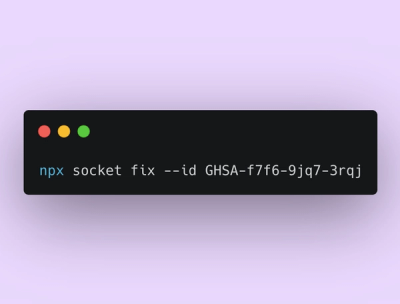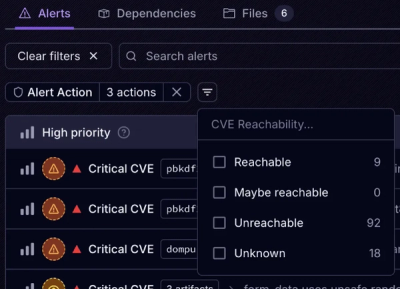
Product
Announcing Socket Fix 2.0
Socket Fix 2.0 brings targeted CVE remediation, smarter upgrade planning, and broader ecosystem support to help developers get to zero alerts.
@hfour/nestjs-json-rpc
Advanced tools
Docs | Contributing | Wiki | MIT Licensed
A JSON-RPC microservice strategy implementation for NestJS.
Currently uses HTTP as the transport layer, with plans to add other options as the need arises.
yarn add @hfour/nestjs-json-rpc
Initialize similar to a regular microservice, but pass a JsonRpcService as the strategy option:
const app = await NestFactory.createMicroservice(ApplicationModule, {
const app = NestFactory.create(ApplicationModule);
app.connectMicroservice({
strategy: new JsonRpcServer({
path: "/rpc/v1",
port: 8080
server: app.getHttpAdapter()
})
});
await app.startAllMicroservicesAsync();
await app.listenAsync(3000);
Decorate your controllers with the @RpcService and @RpcMethod decorators:
@RpcService({
namespace: "test"
})
export class TestController implements ControllerImplementation<ITestService> {
@RpcMethod()
public async myMethod(params: any) {
console.log("The method called was test.myMethod");
return params;
}
}
All the methods of the service will automatically be added with the name <namespace>.<method>.
Use any standard microservice decorators you would like to use:
@UsePipes(TestPipe)
@UseInterceptors(TestInterceptor)
@UseGuards(TestGuard)
@RpcMethod()
public async myMethod(params: any) {
//...
}
For the different types of decorators, see:
Running in Hybrid Mode allows you to use a JSON-RPC endpoint alongside an existing Nest.JS application, using the same port. This could be used to run side-by-side with a Healthcheck endpoint, for example. All the decorators remain the same, but the initialization of the microservice should be modified as follows:
const app = NestFactory.create(ApplicationModule);
app.connectMicroservice({
strategy: new JsonRpcServer({
path: "/rpc/v1",
server: app.getHttpAdapter()
})
});
await app.startAllMicroservicesAsync();
await app.listenAsync(3000);
nestjs-json-rpc also comes with a way to create clients!
Simply initialize the client in any other service, then ask it to create a proxy for TestService for the given namespace:
@Injectable()
class MyServiceClient {
private client = new JsonRpcClient("http://localhost:8080/rpc/v1");
private service = this.client.getService<ITestService>("test");
public doSomething() {
// Invoke it just as if its a local service!
return this.service.myMethod(paramsHere);
}
}
You may also pass client headers to be sent with every request, such as the authorization token
let client = new JsonRpcClient("http://localhost:8080/rpc/v1", {
Authorization: `Bearer ${token}`
});
You can write E2E tests with super-test, similar to the NEST.JS Documentation. This will allow you to write tests without spinning up an HTTP Server (and using a real port).
const moduleFixture = await Test.createTestingModule({
imports: [ApplicationModule]
})
.overrideProvider(ISomeProvider)
.useClass(MockSomeProvider)
.compile();
app = moduleFixture.createNestApplication();
app.connectMicroservice({
strategy: {
path: "/rpc/v1",
server: app.getHttpAdapter()
}
});
await app.startAllMicroservicesAsync();
await app.init();
await request(app.getHttpServer())
.post("/rpc/v1")
.send({
jsonRpc: "2.0",
method: "namespace.method",
params: { foo: "bar" }
})
.expect(200)
.expect({
jsonrpc: "2.0",
result: {
message: "Hello World!"
}
});
You can access additional metadata info about the request (such as headers) using the context.
For example, to access the Authorization header within a guard:
@Injectable()
class TestGuard implements CanActivate {
canActivate(
ctx: ExecutionContext
): boolean | Promise<boolean> | import("rxjs").Observable<boolean> {
let authData = ctx
.switchToRpc()
.getContext<JsonRpcContext>()
.getMetadataByKey("Authorization");
if (authMetadata) {
// ... check token
return true;
}
return false;
}
}
To enable different transports in the future, the metadata mechanism doesn't reveal the metadata transport method. This should allow for the option to implement a different (e.g. TCP based) transport in the future.
Ideally, you should be using a per-request scope to manage custom data. However, since this NestJS functionality is fairly new and unexplored, JsonRpcContext allows you to store and retrieve custom context data in a type-safe way via the property customData
Contextual data pertaining to a single remote procedure call (a single "request") can be stored within this property.
To use this property, you need to instantiate a TypesafeKey.
The following example decodes and adds user info to the context. JWT is extracted from the RPC request metadata (the Authorization header for our HTTP transport)
import { TypesafeKey } from "@hfour/nestjs-json-rpc";
import { UserInfo } from "./my-code";
export const UserInfoKey = new TypesafeKey<UserInfo>("myapp:auth:UserInfo");
export class TestAuthenticateGuard implements CanActivate {
public async canActivate(context: ExecutionContext): Promise<boolean> {
const ctx = context.switchToRpc().getContext<JsonRpcContext>();
let jwtMetadata = ctx.getMetadataByKey("Authorization");
if (!jwtMetadata) return false;
const decoded: Result<UserInfo> = jwt.decodeBearer(jwtMetadata);
if (decoded.error) return false;
ctx.customData.set(UserInfoKey, decoded.result);
return true;
}
}
Then you can read it by injecting the context in the RPC method:
@UseGuards(TestAuthenticateGuard)
@RpcMethod()
public async getUserInfo(params: {}, @Ctx() ctx: JsonRpcContext) {
const userData = ctx.customData.get(UserInfo);
return Promise.resolve(data?.name);
}
Or you could read the data from another guard, pipe or interceptor.
Note that you are responsible for managing the key space of custom data and ensuring there are no name conflicts.
nestjs-json-rpc comes with CodedRpcException, which as per JSONRPC spec allows you to include an error code and additional data to the error. The error is reconstructed on the client and you can access and check the code and the data there as well.
Feel free to define your own code constants and declare a union of the types in order to be able to discriminate the codes:
function isValidationError(e: CodedRpcException);
try {
await this.service.myMethod(paramsHere);
} catch (e) {
if (e.code === Codes.ValidationError) {
// access validation errors here:
e.data.validationErrors;
}
}
You may also implement your own error hierarchy by means of subclassing, but you will not be able to use the instanceof checks on the client as errors are not reconstructed. Instead we recommend the following approach:
const ValidationErrorCode = 400;
type ValidationErrorCode = 400;
type ValidationError = CodedRpcException & {
code: ValidationErrorCode;
data: {
validationErrors: Array<{ path: string; problem: string }>;
};
};
function isValidationError(e: any): e is ValidationError {
return e instanceof CodedRpcException && e.code === ValidationErrorCode;
}
FAQs
JSON-RPC module for NestJS framework
We found that @hfour/nestjs-json-rpc demonstrated a not healthy version release cadence and project activity because the last version was released a year ago. It has 9 open source maintainers collaborating on the project.
Did you know?

Socket for GitHub automatically highlights issues in each pull request and monitors the health of all your open source dependencies. Discover the contents of your packages and block harmful activity before you install or update your dependencies.

Product
Socket Fix 2.0 brings targeted CVE remediation, smarter upgrade planning, and broader ecosystem support to help developers get to zero alerts.

Security News
Socket CEO Feross Aboukhadijeh joins Risky Business Weekly to unpack recent npm phishing attacks, their limited impact, and the risks if attackers get smarter.

Product
Socket’s new Tier 1 Reachability filters out up to 80% of irrelevant CVEs, so security teams can focus on the vulnerabilities that matter.